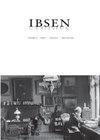Nature, Pathos, Heroism: Victor Sjöström’s Silent Film Adaptation (1917) of Ibsen’s “Terje Vigen” (1862)
IF 0.1
0 THEATER
引用次数: 1
Abstract
Launched in 1917, Victor Sj€ ostr€ om’s famous film adaptation of Ibsen’s “Terje Vigen” celebrated its centenary in 2017 (Sj€ ostr€ om 2006).The film was directed by the highly regarded Swedish artist Victor Sj€ ostr€ om, who also played the leading role. In the film, which was a huge success worldwide, the Norwegian coastal landscape is portrayed in imposing and powerful nature imagery. Sj€ ostr€ om was a pioneer in developing the use of landscape imagery in fiction filmmaking. This article deals with the film as an adaptation of Ibsen’s epic poem, and the main focus will be on the representation of nature in the film. How is nature exploited? How do the nature pictures relate to still landand seascapes of the pictorial art tradition? What symbolic and ideologic functions do they have? The overall argument is that Sj€ ostr€ om’s film, through its strong emphasis on nature, atmospherics and emotions as well as drama, complicates the heroism of Terje Vigen, and, moreover, that this actually picks up on something that is latent in Ibsen’s poem.自然、病理、英雄主义:维克托·舍斯特伦的无声电影改编自易卜生的《守望者》(1862)(1917)
1917年推出的维克多·奥斯特洛夫斯基改编自易卜生的著名电影《天堂》在2017年庆祝了它的百年诞辰(2006年)。这部电影是由备受尊敬的瑞典艺术家维克多·奥斯特勒姆执导的,他也担任了主角。在这部在世界范围内取得巨大成功的电影中,挪威的海岸景观被描绘成壮观而强大的自然意象。奥斯特罗姆是在虚构电影制作中运用景观意象的先驱。这篇文章将这部电影作为易卜生史诗的改编,主要关注的是电影中对自然的表现。大自然是如何被利用的?自然画面如何与绘画艺术传统的静态陆地海景相联系?它们具有什么样的象征和意识形态功能?总的观点是,奥斯特罗姆的电影,通过对自然、氛围和情感以及戏剧的强烈强调,使特耶·维根的英雄主义变得复杂,而且,这实际上是在易卜生的诗中发现了一些潜在的东西。
本文章由计算机程序翻译,如有差异,请以英文原文为准。
求助全文
约1分钟内获得全文
求助全文

 求助内容:
求助内容: 应助结果提醒方式:
应助结果提醒方式:


